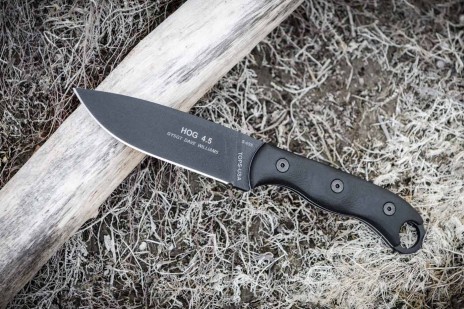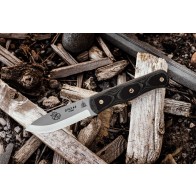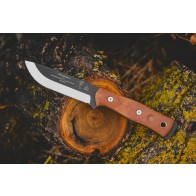HOG 4.5
Hunter Of Gunmen
HOG is a name earned by a certified US Marine Scout Sniper. HOG means Hunter Of Gunmen because we hunt men with guns. We HOGs are a force multiplier for any commander who chooses to employ us. The design for this blade started somewhere in my history that I cannot fully trace. It began in the early years of my career as a young Marine Infantryman. After spending days or weeks at a time in a field environment it seemed that my hands would always ache. I eventually traced this pain back to the blades that I was carrying and using. The Tacti-cool handles on those blades all had rough edges and sharp corners. Sure they were mean to look at and gripped like a gator but they didn't have the comfort that I needed for sustained field use. After this realization, I set out to design the best knife handle that I could in my limited experience. Little did I know at the time, this would take the better part of my career to complete.
I started with a piece of wooden closet rod and carved in the features that I most liked in many of the knives that I have used. I kept this in my pack for a long time and modified it with a piece of sandpaper as I discovered new ways to use a knife. Whenever one of my field knives earned me a hot spot I grabbed that little handle mock-up and made a subtle change so that it did not irritate that hot spot. This went on for many years and many times this piece was overworked and restarted new. Eventually, I had the handle shape that worked wonderfully in my hand. So I looked to buy a knife that had a handle close to the one that I had designed. I found one and set out on the next phase of simply using the blade as much as possible while making subtle changes to the handle. This also led to my developing a greater understanding of how to use a knife to accomplish field tasks while also conserving energy. With the handle done I realized that there was another problem brewing. The blade designs were just not up to the task that I needed them for.
Some of the better shapes were too thick and some too flimsy. Some had bad edge geometry that would just not hold the keen edge needed for a good field knife. This continued throughout many years and on to my instructor position at the 1st Marine Division Scout Sniper School. I was fortunate in that I was the primary instructor for survival, fieldcraft, and combat tracking. This gave me the opportunity to sample many, many knives that my students had in their kit. Believe me, Snipers love knives like coyotes love meat. In doing this I developed an attraction to wide blades with keen edge geometry. The problem was that there were not any available that I could find that would meet both my blade and handle requirements. Not that I was the expert but I knew what I needed and that was good enough for me. So now, I was armed with this Ideal field knife that does not exist. So I set out to make this knife exist.
I made a wooden knife from start to finish and carried that in my pack everywhere so every time that I had an issue with whatever knife I was carrying, I could sand my wooden blank to remedy it. Some Marines thought that I was crazy being a Marine Sniper in the field with a wooden knife in my pack. I just claimed that I was doing research and development, which usually quieted wanna-be's and mall ninjas. Nevertheless, I continued to refine the design. Fast forward a few deployments and I landed a job at the Mountain Warfare Training Center as the SNCOIC of Mountain Survival and Mountain Scout Sniper Courses. Of course that meant lots of field time. In order to be a qualified red hat you have to complete winter and summer mountain leader courses and that means practically living on the mountain. I continued to refine the design until I could think of no more refinements. Then, one time on the mountain while skinning a rabbit I set my knife in the snow and the knife disappeared. Already half starved there was no way that I was going to dig down and retrieve it so I went back to the drawing board with my knife design. I wanted a way to retain my blade and not have to have six feet of dummy cord attached to it. That is when the hole was born.
I made the hole big enough to handle a standard issue carabineer so that it could be clipped to my gear rather than set on the ground when working. It is a bad idea to put a bloody blade back in the case while skinning game, if you do, you will only do it once after you learn that lesson. This worked well and eventually, I discovered many uses for that hole.
When I thought that I had the design about as good as I could make it I sent it, and a larger version of it, to my good friend and mentor Ron Hood. I had asked for his opinion on the overall design, and I asked him if he could find any obvious flaws in the design that I may have overlooked. Ron never got back to me as he was busy with his new magazine and all the other projects that he had going on. So I let the issue rest. At first, I figured that Ron must not have liked it, but then I realized that if he didn't then he would say so. I have never known Ron Hood to sugarcoat anything, perhaps that's why we got along so well. It is comforting to know people who can handle the truth. Well, much to my surprise I soon received a package in the mail. The package was from Ron and it contained two complete knives of my design, rendered exactly as I had designed them. I immediately called Ron to thank him and scold him for such a wonderful gift. He told me that since I designed these knives over many years for how I use a knife then his opinion was irrelevant. So he had them made by Luke Swenson so I could take them to the International SERE Instructors course winter portion in Elverum Norway. So I did just that. For three weeks in that portion of the course, I traveled all over the Norwegian countryside, on skis and homemade snowshoes. The knives provided me with shelter, fire, water, food, and the ability to craft practically anything that I needed to survive. Most importantly, they did not create hot spots or blisters on my overworked hands. My instructors and fellow students admired the blade and my ability to use it effectively for survival tasks. Back home on the mountain, it served me well for the remainder of my tour. It is still to this day my favorite blade and you will rarely ever find me without some version of it on my belt.
The beautiful lines of this knife were an unintended quality that verifies the saying "form follows function." Another important feature that I built into the knife is that the tip of the blade is lined directly in the center of the handle. This is important because it provides the user with tip awareness similar to an ice pick. For some reason, the brain seems to be able to calculate exactly where that tip is even when working blind inside of an animal carcass. This tip awareness is valuable in any combatants' kit because you never know when you may have to transition between opening an MRE and ventilating insurgents. The carabineer hole in the back was never intended to be a gimmick and I don't believe that it is. It was born out of necessity and has proved many times over that it is well worth the small patch of real estate that it occupies in the handle. I discovered many uses for that little hole over the years. It makes a great lever for almost any task requiring a little more leverage, like braking up kindling and fire straightening expedient arrow shafts when they are hot. I have broken the bones of small game to expose the marrow for soups. I have used it to strip small branches clear of twigs and even as a gauge to make a split piece of wood round enough to use for a bow drill. A carabineer clipped in the hole makes a stout handle extension to aid in the blade's chopping power when used in conjunction with a rear pinch grip. I have used it as a pot lifter and even to pull stuck tent stakes from the frozen ground. The truth is that the hole is limitless in its possibilities and the more you carry and use this blade the more uses that you will find for it. It is, much like the Marine Scout Sniper, a force multiplier and you will be glad to have it by your side when it matters.
| Knife Type | Fixed Blade |
|---|---|
| Overall Length | 9.75" |
| Blade Length | 4.38" |
| Blade Thickness | 0.190" |
| Blade Steel | 1095 RC 56-58 |
| Blade Finish | Black Traction Coating |
| Handle Material | Black Linen Micarta |
| Knife Weight | 8.3 oz |
| Weight w/ Sheath | 12.5 oz |
| Sheath Included | Yes |
| Sheath Material | Black Leather |
| Sheath Clip | Dangler |
| Designer | David Norseman Williams USMC (Ret) |
- Love it, but....
- This is an absolutely great knife. One could not go wrong if you wanted to invest in a quality knife. I did however have to make some "modifications". The first thing I did was remove the bed liner coating. If you take care of your knives, you're not going to need this. Next I used a Dremmel to make a 1", 90* spine. I don't generally use my knives to start fires, but just in case. I got the leather dangler sheath with my order. I'm not a fan of dangler sheaths for these types of knives. I just (five minutes ago) ordered a leather backed kydex sheath. Hopefully it works out. I figure the modifications I made aren't doing the knife an injustice considering the designer spent years tweaking it to his likes/dislikes. I just made it fit me more than the original designer. (Posted on 6/14/2023)
- Highly recommended
- Extreme Quality, well balanced. One of my most desirable tools for guiding. Highly recommended (Posted on 11/29/2021)
- Great Knife, two Complaints
- Overall this is a great knife. Comfort is amazing, absolutely zero hot spots when using the knife for camp chores. Blade profile fits my needs perfectly and holds an edge really well. To me this is one good looking knife. That being said I have two complaints. The first is the sheath is not great. The bushcraft one is better but at least personally, I'm not a fan of sheaths that cover a large portion of the handle. The second is the lack of a spot to strike a ferro rod. Even if you remove some finish on the back of the blade it is too soft and deforms the metal. I've heard some people had success using the ring but I have yet to try. Even though I've typed a lot I do not regret this knife. A ground down saw blade and a nice custom sheath solved both of these issues. Again, this is a great knife! (Posted on 11/8/2019)















